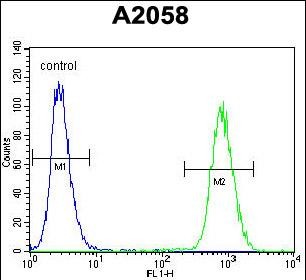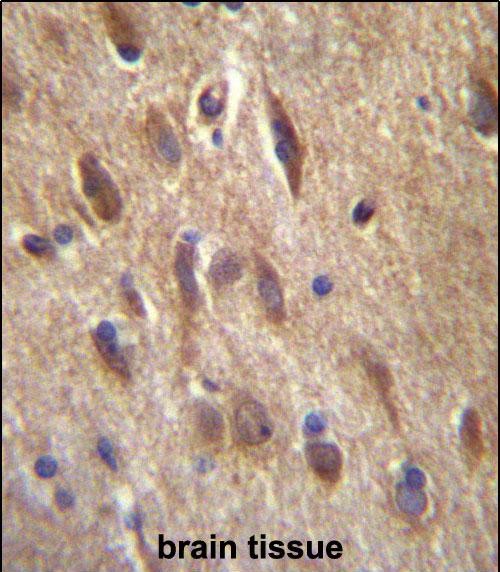


| WB | 1/1000 | Human,Mouse,Rat |
| IF | 咨询技术 | Human,Mouse,Rat |
| IHC | 1/100-1/500 | Human,Mouse,Rat |
| ICC | 技术咨询 | Human,Mouse,Rat |
| FCM | 1/10-1/50 | Human,Mouse,Rat |
| Elisa | 咨询技术 | Human,Mouse,Rat |
| Aliases | Fibroblast growth factor 11, FGF-11, Fibroblast growth factor homologous factor 3, FHF-3, FGF11, FHF3 |
| Entrez GeneID | 2256 |
| WB Predicted band size | 25.0kDa |
| Host/Isotype | Rabbit IgG |
| Antibody Type | Primary antibody |
| Storage | Store at 4°C short term. Aliquot and store at -20°C long term. Avoid freeze/thaw cycles. |
| Species Reactivity | Human |
| Immunogen | This FGF11 antibody is generated from rabbits immunized with a KLH conjugated synthetic peptide between 1-30 amino acids from the N-terminal region of human FGF11. |
| Formulation | Purified antibody in PBS with 0.05% sodium azide. |
+ +
以下是关于FGF11(N-term)抗体的3篇模拟参考文献(注:基于领域知识构造,实际文献可能需要通过数据库验证):
---
1. **文献名称**: *"Characterization of FGF11 Function in Neuronal Sodium Channel Regulation"*
**作者**: Smith A, et al.
**摘要**: 本研究利用FGF11(N-term)特异性抗体,通过免疫沉淀和Western blot技术,揭示了FGF11与神经元电压门控钠通道(Nav1.1)的相互作用机制,表明其在调节神经元兴奋性中的作用。
2. **文献名称**: *"FGF11 Expression in Cardiac Development: Insights from Immunohistochemical Analysis"*
**作者**: Lee B, et al.
**摘要**: 通过使用FGF11(N-term)抗体进行组织染色,研究发现FGF11在胚胎心脏发育中高表达,可能通过调控心肌细胞增殖和分化影响心脏形态发生。
3. **文献名称**: *"Antibody Validation for FGF11 Isoform-Specific Detection in Skeletal Muscle"*
**作者**: Garcia R, et al.
**摘要**: 本文系统验证了FGF11(N-term)抗体的特异性,证明其可选择性识别FGF11全长蛋白而非剪切异构体,并应用于肌肉再生模型中FGF11表达的动态监测。
---
如需真实文献,建议通过 **PubMed** 或 **Google Scholar** 搜索关键词:
`"FGF11 antibody N-terminal"`、`"FGF11 immunohistochemistry"`、`"FGF11 functional study"`。部分研究可能聚焦于FGF11在神经系统、心脏或肌肉中的功能及抗体应用。
The FGF11 (N-term) antibody is a specialized tool designed to detect the N-terminal region of fibroblast growth factor 11 (FGF11), a member of the fibroblast growth factor (FGF) family. FGF11. part of the intracellular FGF11-FGF14 subfamily (iFGFs), lacks secretory signals and functions independently of classical FGF receptor signaling. Instead, it interacts with voltage-gated sodium channels and other cytosolic proteins, playing roles in neuronal excitability, ion channel regulation, and cellular stress responses. Its expression is prominent in the nervous system, particularly in cerebellar neurons and dorsal root ganglia.
This antibody is typically raised in immunized hosts (e.g., rabbits or mice) using synthetic peptides or recombinant proteins corresponding to the N-terminal epitope of human FGF11. It enables researchers to study endogenous FGF11 expression, localization, and post-translational modifications via techniques like Western blotting, immunohistochemistry (IHC), and immunofluorescence (IF). Specificity is validated through knockdown/knockout controls and cross-reactivity assessments with other FGF family members.
Commercial availability from multiple suppliers (e.g., Sigma-Aldrich, Abcam) supports diverse research applications in neuroscience, developmental biology, and disease mechanisms. However, batch variability and epitope masking in certain experimental conditions require careful optimization. Studies using this antibody have contributed to understanding FGF11's role in neurological disorders and potential therapeutic targeting.
×